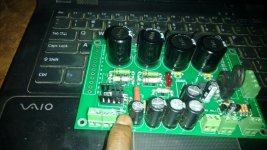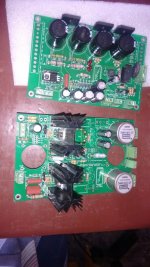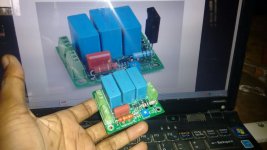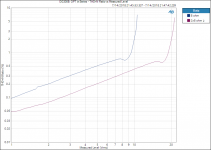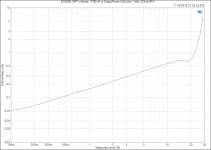Yes, the lesson... when you do push things, things want to resist and those things then run hotter.... heatsink to be changed cause 78 degrees Celsius is not optimal, you burn your fingers and the tubes run hotter, 6N6P at 105-109 dergrees and 300B at 172-174 degrees Celsius.
I wouldn't worry about the tubes. Watch the tubes in a dark room after they've been running for an hour or more. If the plates (tube structures) are their usual dull grey, you're fine. If they are developing a bit of cherry glow, you need to dial the bias down.
78 ºC on an external heat sink is way too much. Please use the spreadsheet I sent you when you ordered the boards, the Maida Calculator. It'll calculate the appropriate heat sink for you.
If you don't know the thermal resistance of the heat sink you have, follow the directions for figuring it out near the top of this page: LM3886 chip power amplifier thermal design.
Good luck with your source distortion gremlin. That'll be an interesting one to track down.
Tom
No gain.....
Ok, Gremlin gone!!
The amp sound lovely and now it is on trial in the living room for a week before the big makover..... It is to be presentable!
Though (I thought I was through this part) if I play music from my computer to the DAC and directly to the amp it sound lovely, I have gain and can regulate sound volume from the computer but when connecting the Thule as pre amp.... quiet!
Not really quiet but I have such reduced signal that with full volume I can barely hear the music in the speakers, what is this??
I don't understand why my Thule is doing this to me! When running it agianst the Le Monstre it is no problem but now with the DG300B....
When running it agianst the Le Monstre it is no problem but now with the DG300B....
Does it have anything to do with my caps on incoming signal or am I stupid again? Don't know if I have caps on the pre out from the Thule but could that cause this kind of phenomenon?
Would appreciate some hint or even help here cause I don't figure it out myself, the only thing that come to mind are those caps.
Ok, Gremlin gone!!
The amp sound lovely and now it is on trial in the living room for a week before the big makover..... It is to be presentable!
Though (I thought I was through this part) if I play music from my computer to the DAC and directly to the amp it sound lovely, I have gain and can regulate sound volume from the computer but when connecting the Thule as pre amp.... quiet!
Not really quiet but I have such reduced signal that with full volume I can barely hear the music in the speakers, what is this??
I don't understand why my Thule is doing this to me!
Does it have anything to do with my caps on incoming signal or am I stupid again? Don't know if I have caps on the pre out from the Thule but could that cause this kind of phenomenon?
Would appreciate some hint or even help here cause I don't figure it out myself, the only thing that come to mind are those caps.
The DG300B has pretty low gain (about 10 dB with cap coupled input, 7 dB with transformer coupled input), so you actually have to turn the volume knob a bit to get output. With cap coupled input, the DG300B requires 2.75 V in to drive it to clipping. 3.9 V with transformer coupled input. A modern DAC will provide 2.0 V and pro level gear 4.0 V, so there's no issue there. However, many sources of yesteryear only put out a few hundred mV, so you'll need a preamp with gain for them to drive the DG300B.
If you're using transformer coupled input, my THAT Driver or DIFF PRE are good choices. For cap coupled input, you can put together a simple opamp gain stage to boost the input voltage a bit.
Tom
If you're using transformer coupled input, my THAT Driver or DIFF PRE are good choices. For cap coupled input, you can put together a simple opamp gain stage to boost the input voltage a bit.
Tom
Attached are some images of the populated PCBs. The chassis is going to be a teak wood frame with a copper top plate. This build is not a simple build, getting all the components from Digikey, SMD soldering and now the final stages has taken time. I look forward to the final result,and will post photos once it's done and working.
Cheers
George
Cheers
George
Attachments
Two years later and still some issues.
Ok, I thought that today was the last day of my Damn Good 300 B, build process but not.
I have been building, testing and enjoying the DG300B amp for almost a year in between but now I took the oppertunity to finish the aluminium work and the wood chassi also. The result I think is rather classy but there is a minor..... problem.
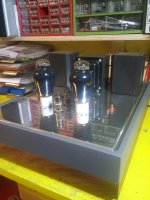
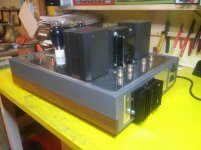
The DG300B don't want to play with my Aleph P1.7 preamp.
Without the preamp connected I get it to play nicely directly from DAC and CD-player and I regulate volume directly from either the computer or not at all (when playing CD) just as I have done the past year when it has been playing in the living room, lovely.
As soon as I connect the preamp, which I have built from Nelson Pass original schematics, I don't get anything out from the DG300B, silence!
I don't know if it is the capacitor that I have on the signal in that is messing with me cause the preamp has capacitors on the output. Gain should be enough (16-20 dB) for the DG300B but since it get just silent I wonder if I have to remove the input capacitors since I don't use the Jensen transformers.
Anyone who can confirm or dismiss my thoughts??
I don't see any other reason for this silence than the capacitor on the input but it is strange cause when I run the Aleph P1.7 towards my Hiraga Le Monstre with only 8 watt I can regulate the volume til it's painful to be in the same room but with the DG300B it is silent, even though the tube amp should deliver appr. 8-10 watt.
Help someone!!
Ok, I thought that today was the last day of my Damn Good 300 B, build process but not.
I have been building, testing and enjoying the DG300B amp for almost a year in between but now I took the oppertunity to finish the aluminium work and the wood chassi also. The result I think is rather classy but there is a minor..... problem.


The DG300B don't want to play with my Aleph P1.7 preamp.
Without the preamp connected I get it to play nicely directly from DAC and CD-player and I regulate volume directly from either the computer or not at all (when playing CD) just as I have done the past year when it has been playing in the living room, lovely.
As soon as I connect the preamp, which I have built from Nelson Pass original schematics, I don't get anything out from the DG300B, silence!
I don't know if it is the capacitor that I have on the signal in that is messing with me cause the preamp has capacitors on the output. Gain should be enough (16-20 dB) for the DG300B but since it get just silent I wonder if I have to remove the input capacitors since I don't use the Jensen transformers.
Anyone who can confirm or dismiss my thoughts??
I don't see any other reason for this silence than the capacitor on the input but it is strange cause when I run the Aleph P1.7 towards my Hiraga Le Monstre with only 8 watt I can regulate the volume til it's painful to be in the same room but with the DG300B it is silent, even though the tube amp should deliver appr. 8-10 watt.
Help someone!!
So I googled "Aleph P1.7" and found a schematic. It looks like a differential preamp. If you're not using the input transformers on the DG300B, how are you connecting this preamp?
If you're not using the input transformers, you must use the input caps, so leave those in place.
If you have an oscilloscope or a multimeter that can resolve, say, 100 mV AC with at least two digits of precision, I suggest going to wantones.com and creating a test tone. 400 Hz, -6 dBFS, 5 seconds. Play it on repeat. Turn up the volume until you have 100 mV out of the preamp. Then plug it into the DG300B and measure the output voltage of the preamp again. I bet you'll find that it has dropped to zero. The next task will be to figure out why.
Should you get stuck, toss me an email and I'll be happy to help.
Tom
If you're not using the input transformers, you must use the input caps, so leave those in place.
If you have an oscilloscope or a multimeter that can resolve, say, 100 mV AC with at least two digits of precision, I suggest going to wantones.com and creating a test tone. 400 Hz, -6 dBFS, 5 seconds. Play it on repeat. Turn up the volume until you have 100 mV out of the preamp. Then plug it into the DG300B and measure the output voltage of the preamp again. I bet you'll find that it has dropped to zero. The next task will be to figure out why.
Should you get stuck, toss me an email and I'll be happy to help.
Tom
Done
Found it!!!
I have been building the DG300B from the first paper that you wrote Tom (Rev 1.0) and don't know if remember the changes you made on the road but I was affected by one major error. I was going through all pictures and build material that I have here since 2 years back and suddenly.... in the wiring diagram from 2016 when I noted out for you that the wiring colours where changed from Classic Tone transformer, there is showing XLR/RCA option and when I look at it the picture I see that the notation from up and down is 1, 3 and 2 on the XLR so single ended should bridge 1 and 3 with signal+ on 2.....
Went back to my documentation Rev 1.0 and.... Ohps, from up and down in the picture it says 2, 3 and 1!
Turned the big pile of iron around again and reconnected..... sweet music is no pouring out of my system even with the preamp connected even though it is eating rather much of the gain. If I want to kill some ears then I have to bypass the preamp..... and talking about the preamp, you wondered how I could connect the Aleph P1.7 balanced to single ended DG300B, here come the answer.
http://www.diyaudio.com/forums/attachments/pass-labs/601271d1487968327-aleph-pass-labs-experience-20170217_110849-jpg
Found it!!!
I have been building the DG300B from the first paper that you wrote Tom (Rev 1.0) and don't know if remember the changes you made on the road but I was affected by one major error. I was going through all pictures and build material that I have here since 2 years back and suddenly.... in the wiring diagram from 2016 when I noted out for you that the wiring colours where changed from Classic Tone transformer, there is showing XLR/RCA option and when I look at it the picture I see that the notation from up and down is 1, 3 and 2 on the XLR so single ended should bridge 1 and 3 with signal+ on 2.....
Went back to my documentation Rev 1.0 and.... Ohps, from up and down in the picture it says 2, 3 and 1!
Turned the big pile of iron around again and reconnected..... sweet music is no pouring out of my system even with the preamp connected even though it is eating rather much of the gain. If I want to kill some ears then I have to bypass the preamp..... and talking about the preamp, you wondered how I could connect the Aleph P1.7 balanced to single ended DG300B, here come the answer.
http://www.diyaudio.com/forums/attachments/pass-labs/601271d1487968327-aleph-pass-labs-experience-20170217_110849-jpg
Dang! You're right. I just double-checked the schematics. The pinout of the input connector is indeed different than the XLR pinout. In all my newer designs, I use pins 1,2, and 3 in the same sequence as the XLR pinout (GND, INP, INN). I guess the DG300B is the exception. Good catch! I also see that I carried through that error in the documentation in two places. Grr! How annoying. I'll get that updated.
Standardized connector pinouts. What a concept...

I do recall adding the new wire colours for the Classic-Tone to the documentation following our conversation. I must have forgotten about the input connector pinout at that time.
Thanks for the follow-up. I'm glad you got it working.
Tom
Standardized connector pinouts. What a concept...
I do recall adding the new wire colours for the Classic-Tone to the documentation following our conversation. I must have forgotten about the input connector pinout at that time.
Thanks for the follow-up. I'm glad you got it working.
Tom
How about 25 W from the DG300B?
Those wanting more power than the 10-12 W the DG300B provides by default may be interested in the following trick:
Connect the two secondaries in series and drive the inputs with the same signal. Now, for this to work you'll need OPTs with 4 Ω taps and use two 4 Ω taps in series to power an 8 Ω speaker (or two 2 Ω taps in series for a 4 Ω speaker). This doubles the output power.
I tried this with a pair of Edcor CXSE25-5K. It works rather well (see attached).
Tom
Those wanting more power than the 10-12 W the DG300B provides by default may be interested in the following trick:
Connect the two secondaries in series and drive the inputs with the same signal. Now, for this to work you'll need OPTs with 4 Ω taps and use two 4 Ω taps in series to power an 8 Ω speaker (or two 2 Ω taps in series for a 4 Ω speaker). This doubles the output power.
I tried this with a pair of Edcor CXSE25-5K. It works rather well (see attached).
Tom
Attachments
Rather annoying, it is not ready.... YET!
I have built this Damn Good 300B and I feel rather good about, ney I feel really proud about it (first tube amp, you know) but then there is some little...... you know, something.....
I don't know if it is me, not being used to a tube amp or if I have made something wrong or if there is something wrong with my amp but the more I listen to it the more annoying it become.
I have imagined the 300B amp something really... WOW!
It should be the juwel in the Hifi-crown here at home.
It is built according to build instruction, it is built according to BOM except some better resistors in sensitive places, I have confirmed measured votages here in this thread and Tom has also confirmed that I am right.
Some small issues where I have afterwords corrected my mistakes so no big issues.
My Hiraga Le Monstre, without proper PSU, is killing this 300B amp!!!
Sound stage, highs and lows, musicality..... what more... everything.
I don't know if I have had my expectations wound up to high, from what I have heard around on the Internet what a 300B can do, this tube amp should rock my world it should be IT.
It does have it, it has some nasty distortion coming through all music that is played. From the beginning it was like a spooky, stubborn idea, you know that kind of ideas that you don't get out of your head but now after a year listening to the amp, it is bloody killing my music.
Hey, don't think that I am blaming anyone for this and defenitely not Tom Christensen who have done a fantastic work with this amp (and by the way, an amazing man when it come to support and answering stupid newbie questions).
I am absolutely shure that I have succeded screwing things up, somehow, somewhere on the road but I am not man to see where.
So, where can this distortion originate? I will try to explain the distortion.
All music that is recorded to computer, CD, vinyl etc. does have a recording level that should be just around or below 0 dB to sound nice. Rather often you can have most of the music piece at around -25 to -40 dB and only some spikes at -10 to 0dB.
Everything that I play, I really mean everything, exceeding -25 to -20 dB (and that is a lot of music) start to distort terribly, most noticeable in the frequencies below 600 Hz but also at higher frequencies if recording level is higher than -10 dB.
For this reason I believe/know that it is not originating from the design cause if Tom would have designed an amplifier that distorted over all frequencies then he would not get the credits that he does and he would most likely not have sold many of them either.
So, components! I have been through the BOM several times and I can not find any errors made by me in that area….. I will check again to be shure!
My next idea is that I can maybe have routed the cables in a stupid way with interference as result somewhere but I have really tried to have 90 degrees where wires are crossing each other, signal cables have screen and plus/gnd twisted together and so on…..
The only thing that I can come up with now is wire gauge. I don’t know if it is possible (but otherwise I would maybe not consider the possibility that it is possible, so lets go). I start suspecting that the wires that I have used for the OPT (22 gauge), can it be that I have used to thin wires?
I know that the wire theoretically can deliver a lot of amps at 20 degrees Celsius (at least enough I though) but still….. can it be that I should used coarser wire for the OPT?
I just imagine that if I don’t have free flow for the current to the transformer then this bottle neck is transferred into the transformers where it is transformed and multiplied to maybe cause the distortion…..
Next idea, I have built the amp with caps on signal input and the BOM also have the option for Jensen input transformers (just a lot of more money) and according to the build description using input transformers should decrease the input signal with some, a few dB (I think it was written so, at least I understood it so). Whould this entirely eliminate the distortion.....? I don't know.
I hope you don’t say that I am a general nut case now but I am really fishing.
I don’t find any reasonable reason for the distortion. Just because I play normally recorded music it should not distort like that, my Hiraga is playing all kind of music equally good independent recording level.
Tubes vibrating…. ? Maybe but I don’t belive so cause then I should be able to feel/hear the ringing in the tubes (have checked several times with special equipment).
Right now I am measuring 408 V at B+ and bias is set to 0,8 mA. If I try to lower B+ to about 390 V then the distortion is getting at the limit for what is listenable. If I try bias up or down 0.15 mA then I also have more distortion so, I am out of ideas! HELP!
I have built this Damn Good 300B and I feel rather good about, ney I feel really proud about it (first tube amp, you know) but then there is some little...... you know, something.....
I don't know if it is me, not being used to a tube amp or if I have made something wrong or if there is something wrong with my amp but the more I listen to it the more annoying it become.
I have imagined the 300B amp something really... WOW!
It should be the juwel in the Hifi-crown here at home.
It is built according to build instruction, it is built according to BOM except some better resistors in sensitive places, I have confirmed measured votages here in this thread and Tom has also confirmed that I am right.
Some small issues where I have afterwords corrected my mistakes so no big issues.
My Hiraga Le Monstre, without proper PSU, is killing this 300B amp!!!
Sound stage, highs and lows, musicality..... what more... everything.
I don't know if I have had my expectations wound up to high, from what I have heard around on the Internet what a 300B can do, this tube amp should rock my world it should be IT.
It does have it, it has some nasty distortion coming through all music that is played. From the beginning it was like a spooky, stubborn idea, you know that kind of ideas that you don't get out of your head but now after a year listening to the amp, it is bloody killing my music.
Hey, don't think that I am blaming anyone for this and defenitely not Tom Christensen who have done a fantastic work with this amp (and by the way, an amazing man when it come to support and answering stupid newbie questions).
I am absolutely shure that I have succeded screwing things up, somehow, somewhere on the road but I am not man to see where.
So, where can this distortion originate? I will try to explain the distortion.
All music that is recorded to computer, CD, vinyl etc. does have a recording level that should be just around or below 0 dB to sound nice. Rather often you can have most of the music piece at around -25 to -40 dB and only some spikes at -10 to 0dB.
Everything that I play, I really mean everything, exceeding -25 to -20 dB (and that is a lot of music) start to distort terribly, most noticeable in the frequencies below 600 Hz but also at higher frequencies if recording level is higher than -10 dB.
For this reason I believe/know that it is not originating from the design cause if Tom would have designed an amplifier that distorted over all frequencies then he would not get the credits that he does and he would most likely not have sold many of them either.
So, components! I have been through the BOM several times and I can not find any errors made by me in that area….. I will check again to be shure!
My next idea is that I can maybe have routed the cables in a stupid way with interference as result somewhere but I have really tried to have 90 degrees where wires are crossing each other, signal cables have screen and plus/gnd twisted together and so on…..
The only thing that I can come up with now is wire gauge. I don’t know if it is possible (but otherwise I would maybe not consider the possibility that it is possible, so lets go). I start suspecting that the wires that I have used for the OPT (22 gauge), can it be that I have used to thin wires?
I know that the wire theoretically can deliver a lot of amps at 20 degrees Celsius (at least enough I though) but still….. can it be that I should used coarser wire for the OPT?
I just imagine that if I don’t have free flow for the current to the transformer then this bottle neck is transferred into the transformers where it is transformed and multiplied to maybe cause the distortion…..
Next idea, I have built the amp with caps on signal input and the BOM also have the option for Jensen input transformers (just a lot of more money) and according to the build description using input transformers should decrease the input signal with some, a few dB (I think it was written so, at least I understood it so). Whould this entirely eliminate the distortion.....? I don't know.
I hope you don’t say that I am a general nut case now but I am really fishing.
I don’t find any reasonable reason for the distortion. Just because I play normally recorded music it should not distort like that, my Hiraga is playing all kind of music equally good independent recording level.
Tubes vibrating…. ? Maybe but I don’t belive so cause then I should be able to feel/hear the ringing in the tubes (have checked several times with special equipment).
Right now I am measuring 408 V at B+ and bias is set to 0,8 mA. If I try to lower B+ to about 390 V then the distortion is getting at the limit for what is listenable. If I try bias up or down 0.15 mA then I also have more distortion so, I am out of ideas! HELP!
It has some nasty distortion coming through all music that is played.
What is the source being used, have you tried a DC blocking capacitor at the amp input?
Maybe some DC is present in the source, causing problems for the input transformer.
Last edited:
What is the source being used, have you tried a DC blocking capacitor at the amp input?
Maybe some DC is present in the source, causing problems for the input transformer.
It is built with capacitors at the input but I have option to use input transformers, just a matter of money.
Doesn't matter the source, cd player, cd transport and DAC or computerb same problem.
And by the way, it is 80 mA I have at bias.
Last edited:
Doesn't matter the source, cd player, cd transport and DAC or computerb same problem.
Seems you need to get some test equipment hooked up to the amp to get any farther.
This must be a substantial problem.
Last edited:
Saturation!!?
Been going through the construction "book" (a lot of pages) and I don't find anything that should be fishy construction- or design-wise and as I said yesterday, it is most likely me who have done something that I don't understand.
Among all papers about the Damn Good 300B I also found the specifications for both power transformer and OPT and.... hello!
Is it me again?
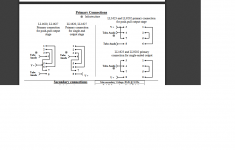
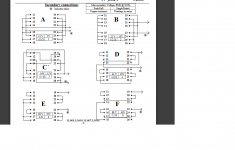
The primary side is straight forward, not very much that can go wrong but the secondary side....
I have been using the "C" set up but as you notice in single end set up the "C" configuration only allow 15 V on the secondary side and I started wondering, is that enough??
I take out appr. 11 W from the amplifier and that would indicate that maybe the OPT go into saturation just when things are peaking.... approximately when I experience the distortion, listening to music. Now I don't know what saturation sound like but I can imagine that it will distort in a kind of way, mayby the way it does here.
Is it so that I should have wired the OPT for lets say 30 V instead?
I am rather convinced that the error is mine and this could very well be it!
Been going through the construction "book" (a lot of pages) and I don't find anything that should be fishy construction- or design-wise and as I said yesterday, it is most likely me who have done something that I don't understand.
Among all papers about the Damn Good 300B I also found the specifications for both power transformer and OPT and.... hello!
Is it me again?


The primary side is straight forward, not very much that can go wrong but the secondary side....
I have been using the "C" set up but as you notice in single end set up the "C" configuration only allow 15 V on the secondary side and I started wondering, is that enough??
I take out appr. 11 W from the amplifier and that would indicate that maybe the OPT go into saturation just when things are peaking.... approximately when I experience the distortion, listening to music. Now I don't know what saturation sound like but I can imagine that it will distort in a kind of way, mayby the way it does here.
Is it so that I should have wired the OPT for lets say 30 V instead?
I am rather convinced that the error is mine and this could very well be it!
Have been there, done that!
That is the configuration that I used from the very first beginning and then I learnt a little more about OPT and also spoke with Lundahl and we concluded that C whould be better option cause that sounded straight through really awful.
Maybe I should have learnt more?
What I noticed in the description, on the uppermost line it says Maximum voltage at 30 Hz for either PP or SE so I suspect that if I am anywhere near these 15 volt then the OPT go into saturation which would also support the fact that the distortion is noticable at dynamic peaks.
That is the configuration that I used from the very first beginning and then I learnt a little more about OPT and also spoke with Lundahl and we concluded that C whould be better option cause that sounded straight through really awful.
Maybe I should have learnt more?
What I noticed in the description, on the uppermost line it says Maximum voltage at 30 Hz for either PP or SE so I suspect that if I am anywhere near these 15 volt then the OPT go into saturation which would also support the fact that the distortion is noticable at dynamic peaks.
- Home
- Amplifiers
- Tubes / Valves
- New project, Damn Good 300B amp.
